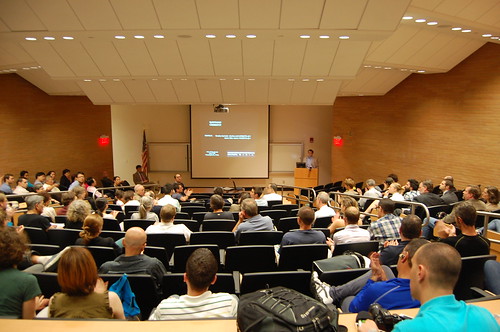More than 100 people attended yesterday's public meeting at Jefferson Hospital's Alumni Hall to learn more about the proposed 10th and 13th Street Bike Lanes. Andrew Stober, Chief of Staff for the Mayor's Office of Transportation and Utilities, gave a 30-minute presentation on the project, then opened the floor to comments.
The City is looking to the Spruce and Pine Street bike lanes as models for the proposed north-south lanes. It is clear Mr. Stober viewed the Spruce and Pine Street lanes as a success, and his presentation included statistics which bolstered that view. The City found overall traffic speeds remained basically unchanged on both streets while reducing the most egregious speeding. Bike traffic doubled and, perhaps best of all, he cited recently-published PennDot crash number showing a 45% reduction in serious crashes along Spruce and Pine Streets in 2010.
We estimated about a third of the attendees were in opposition to, or had serious reservations about, the pilot project. That third seemed more inclined to raise their hand during the open comment portion than the pro-bike lane contingent. Virtually all concerns were about 10th Street; 13th Street seemed to be in the clear. Generally, the concerns fell into three general categories:
- Removing one lane of car traffic will worsen an already-congested street.
- Police enforcement is critical to curtail a bicycling population which currently travels with impunity.
- Removing one lane of traffic will harm 10th Street businesses and endanger patients of medical facilities.
- Brian Sweeney, Director of JEFFSTAT (Jefferson Hospital's Ambulance Services), voiced a number of concerns centered around Jefferson Hospital patients getting to facilities. He called 10th St "a two lane highway" which, by implication, could not afford the loss of one lane.
- A firefighter who has worked in Chinatown for 20 years said, speaking just for himself, that he much preferred to jostle with a bike rather than two lanes of car traffic while trying to navigate an emergency vehicle down the street.
- A woman who claimed to be a bicyclist called 10th St the "worst possible" place to put in a bike lane and a "horrible, horrible, horrible" idea.
- A business owner on 10th and Sansom complained about not being consulted about the bike lane project, and expressed serious concern that removing one car lane would "kill" all the businesses on that street.
- One woman contradicted the City's findings about the Spruce-Pine lanes. She claimed, anecdotally, that the lanes had removed parking, worsened congestion, and not improved bicyclists' behavior.
- Several people said that the 10th and 13th street bike lanes were effectively already installed, and that nothing that would happen would change the City's plans.
- A speaker voiced concern that left-side bike lanes would be confusing to bicyclists accustomed to right-hand lanes, and might result in accidental wrong-way riding.
- Several bicyclists expressed the view that bicyclists should also be viewed as consumers, and that bicyclists (unlike drivers) can easily stop en route, perhaps increasing the commercial potential for businesses located along a bike lane.
- Chinatown business owners expressed concern about the 10th Street lane and its effect upon their businesses and pedestrians crossing the street.
- Many speakers voiced concerns that the City needs to do more enforcement to discourage bad bicycling behavior.
*Note: the comments listed above are based on our recollection and notes of the meeting, not a recoreded transcript. We are working to obtain a copy of the City's presentation, and will post it when we do.


5 comments:
These concerns from business owners and safety officials sound very familiar. Similar worries were expressed in many towns and cities in the Netherlands nearly 50 years ago. Now the Dutch have the safest and most efficient roadways in the world. Their business have flourished and their cities have been revitalized.
The data support cycling. The idea that car access is a necessity will always remain anecdotal.
For those who continue to say "we're not Copenhagen," remember what some Copenhageners said about new cycling and pedestrian accommodations in the 1960s: "we're not Venice." I'm pretty sure they were wrong, too.
I am a Thomas Jefferson Hospital employee and a daily bike commuter. 10th street is a good choice. It is not a nightmare now (honestly) and creating a buffer instead of 2 lanes of cars is a great idea.
A lot of hospital employees and university students bike to Jefferson daily. Not everyone at Jefferson (or even all administrators) oppose the bike lanes.
Many (most?) Jeff STAT patients come by helicopter. There is valet parking in front of the ER.
Pennsylvania Hospital is also facing the bike lane near their emergency access (and has a bike lane in front of the ambulatory doors to their ER - Spruce) and they are not opposed to the bike lane.
Calming traffic makes sense. Reducing traffic to 1 lane with the buffered bike lane benefits pedestrians, people parking, bike riders, ambulance drivers, etc.
I am particularly confused by the ambulance comment. When an ambulance comes through everyone is supposed to pull over including bikes. Wouldn't it actually make it easier for the ambulance to get through if there is already a lane devoid of cars, where just bikes have to pull over. I am obviously against the bike lane being used for deliveries, and wouldn't want buses either, but sharing with ambulances seems fine. Am I missing anything here?
Also, if they were identified, would you mind mentioning which businesses were opposed to the bike lanes? Nothing nefarious in mind, just curious:)
To my recollection, the business owner who spoke at the meeting did not identify his business. He also left halfway through the comment portion of the evening.
He said his business was at 10th and Sansom.
Post a Comment